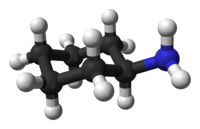Cyclohexylamine
| Cyclohexylamine[1] | |
|---|---|
 | |
 | |
| IUPAC name Cyclohexanamine | |
| Other names Aminocyclohexane | |
| Identifiers | |
| CAS number | 108-91-8 |
| PubChem | 7965 |
| ChemSpider | 7677 |
| UNII | I6GH4W7AEG |
| EC number | 203-629-0 |
| KEGG | C00571 |
| ChEBI | CHEBI:15773 |
| RTECS number | GX0700000 |
| Jmol-3D images | Image 1 |
| |
| |
| Properties | |
| Molecular formula | C6H13N |
| Molar mass | 99.17 g mol−1 |
| Appearance | clear to yellowish liquid |
| Odor | strong, fishy, amine odor |
| Density | 0.8647 g/cm3 |
| Melting point | −17.7 °C; 0.1 °F; 255.5 K |
| Boiling point | 134.5 °C; 274.1 °F; 407.6 K |
| Solubility in water | Miscible |
| Solubility | very soluble in ethanol, oil miscible in ethers, acetone, esters, alcohol, ketones |
| Acidity (pKa) | 10.64[2] |
| Refractive index (nD) | 1.4565 |
| Hazards | |
| S-phrases | S36 S37 S39 |
| R/S statement | R21 R23 R25 R36 R37 R38 R41 |
| NFPA 704 |
 3
3
0
|
| Flash point | 28.6 °C; 83.5 °F; 301.8 K |
| Autoignition temperature | 293 °C; 559 °F; 566 K |
| LD50 | 156 mg/kg (rat, oral) |
| Except where noted otherwise, data are given for materials in their standard state (at 25 °C (77 °F), 100 kPa) | |
| Infobox references | |
Cyclohexylamine is an organic compound, belonging to the aliphatic amine class. It is a colorless liquid, although like many amines, samples are often colored due to contaminants. It has a fishy odor and is miscible with water. Like other amines, it is a weak base, compared to strong bases such as NaOH, but it is a stronger base than its aromatic analog, aniline.
It is a useful intermediate in the production of many other organic compounds. It is a metabolite of cyclamate
Preparation
Cyclohexylamine is produced by two routes, the main one being hydrogenation of aniline using cobalt or nickel catalysts:[3]
- C6H5NH2 + 3 H2 → C6H11NH2
It is also prepared by alkylation of ammonia using cyclohexanol.
Applications
Cyclohexylamine is used as an intermediate in synthesis of other organic compounds. It is the precursor to sulfenamide-based reagents used as accelerators for vulcanization. It is a building block for pharmaceuticals (e.g., mucolytics, analgesics, and bronchodilators). The amine itself is an effective corrosion inhibitor. Some sweeteners are derived from this amine, notably cyclamate. The herbicide hexazinone is derived from cyclohexylamine.[3]
Toxicity
LD50 (rat; p.o.) = 0.71 ml/kg[4]
Safety
It is flammable, with flash point at 28.6 °C. It is toxic by both ingestion and inhalation; the inhalation itself may be fatal. It readily absorbs through skin, which it irritates. It is corrosive. Cyclohexylamine is listed as an extremely hazardous substance as defined by Section 302 of the U.S. Emergency Planning and Community Right-to-Know Act. It has been used as a flushing aid in the printing ink industry.[5]
In regards to occupational exposures, the National Institute for Occupational Safety and Health has suggested workers not be exposed to a recommended exposure limit of over 10 ppm (40 mg/m3) over an eight hour workshift.[6]
References
- ↑ Merck Index, 11th Edition, 2735.
- ↑ H. K. Hall, J. Am. Chem. Soc. (1957) 79 5441.
- ↑ 3.0 3.1 Karsten Eller, Erhard Henkes, Roland Rossbacher, Hartmut Höke "Amines, Aliphatic" in Ullmann's Encyclopedia of Industrial Chemistry, Wiley-VCH, Weinheim, 2005. doi:10.1002/14356007.a02_001
- ↑ The Merck Index, 10th Ed. (1983) p.392, Rahway: Merck & Co.
- ↑ Apps, E. A. (1958). Printing Ink Technology. London: Leonard Hill [Books] Limited. pp. ix.
- ↑ CDC - NIOSH Pocket Guide to Chemical Hazards